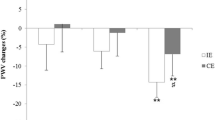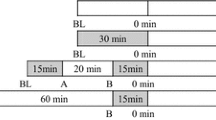Abstract
Purpose
Although acute high-intensity resistance exercise to exhaustion decreases arterial compliance and increases arterial stiffness, the effect of low-intensity resistance exercise (LRE) to exhaustion on arterial compliance and stiffness remains unknown. The present study investigated the acute effects of LRE on arterial compliance and stiffness.
Methods
Ten healthy individuals (age 26 ± 5 years) performed LRE (40 % of 1 repetition maximum) and control (CON: seated rest in the exercise room) trials on separate days in a randomized controlled crossover fashion. The LRE comprised three sets of bench presses to exhaustion with an inter-set rest period of 2 min. In the CON trial, LRE was not performed. Carotid arterial compliance, the β-stiffness index (via simultaneous B-mode ultrasound and applanation tonometry), carotid and brachial blood pressure and heart rate were measured before and at 30 and 60 min after both trials.
Results
Carotid arterial compliance and the β-stiffness index significantly increased and decreased, respectively (both P < 0.05), at 30 and 60 min after the LRE trials, but neither significantly differed after the CON trials. Carotid and brachial blood pressure and heart rate did not change at 30 and 60 min after both trials from baseline.
Conclusion
These results suggest that LRE acutely increases arterial compliance and decreases arterial stiffness.


Similar content being viewed by others
References
Boutouyrie P, Lacolley P, Girerd X, Beck L, Safar M, Laurent S (1994) Sympathetic activation decreases medium-sized arterial compliance in humans. Am J Physiol 267:H1368–H1376
Casey DP, Beck DT, Braith RW (2007) Progressive resistance training without volume increases does not alter arterial stiffness and aortic wave reflection. Exp Biol Med (Maywood) 232:1228–1235
Chodzko-Zajko WJ, Proctor DN, Fiatarone Singh MA, Minson CT, Nigg CR, Salem GJ, Skinner JS (2009) American College of Sports Medicine position stand. Exercise and physical activity for older adults. Med Sci Sports Exerc 41:1510–1530
Cortez-Cooper MY, DeVan AE, Anton MM, Farrar RP, Beckwith KA, Todd JS, Tanaka H (2005) Effects of high intensity resistance training on arterial stiffness and wave reflection in women. Am J Hypertens 18:930–934
DeVan AE, Anton MM, Cook JN, Neidre DB, Cortez-Cooper MY, Tanaka H (2005) Acute effects of resistance exercise on arterial compliance. J Appl Physiol 98:2287–2291
Fahs CA, Heffernan KS, Fernhall B (2009) Hemodynamic and vascular response to resistance exercise with l-arginine. Med Sci Sports Exerc 41:773–779
Figueroa A, Hooshmand S, Figueroa M, Bada AM (2010) Cardiovagal baroreflex and aortic hemodynamic responses to isometric exercise and post-exercise muscle ischemia in resistance trained men. Scand J Med Sci Sports 20:305–309
Haskell WL, Lee IM, Pate RR, Powell KE, Blair SN, Franklin BA, Macera CA, Heath GW, Thompson PD, Bauman A (2007) Physical activity and public health: updated recommendation for adults from the American College of Sports Medicine and the American Heart Association. Circulation 116:1081–1093
Heffernan KS, Collier SR, Kelly EE, Jae SY, Fernhall B (2007) Arterial stiffness and baroreflex sensitivity following bouts of aerobic and resistance exercise. Int J Sports Med 28:197–203
Hirai T, Sasayama S, Kawasaki T, Yagi S (1989) Stiffness of systemic arteries in patients with myocardial infarction. A noninvasive method to predict severity of coronary atherosclerosis. Circulation 80:78–86
Kingwell BA, Berry KL, Cameron JD, Jennings GL, Dart AM (1997) Arterial compliance increases after moderate-intensity cycling. Am J Physiol 273:H2186–H2191
Kinlay S, Creager MA, Fukumoto M, Hikita H, Fang JC, Selwyn AP, Ganz P (2001) Endothelium-derived nitric oxide regulates arterial elasticity in human arteries in vivo. Hypertension 38:1049–1053
Maiorana A, O’Driscoll G, Taylor R, Green D (2003) Exercise and the nitric oxide vasodilator system. Sports Med 33:1013–1035
McDonagh MJ, Davies CT (1984) Adaptive response of mammalian skeletal muscle to exercise with high loads. Eur J Appl Physiol Occup Physiol 52:139–155
Mitchell CJ, Churchward-Venne TA, West DW, Burd NA, Breen L, Baker SK, Phillips SM (2012) Resistance exercise load does not determine training-mediated hypertrophic gains in young men. J Appl Physiol 113:71–77
Miyachi M (2013) Effects of resistance training on arterial stiffness: a meta-analysis. Br J Sports Med 47:393–396
Miyachi M, Kawano H, Sugawara J, Takahashi K, Hayashi K, Yamazaki K, Tabata I, Tanaka H (2004) Unfavorable effects of resistance training on central arterial compliance: a randomized intervention study. Circulation 110:2858–2863
Munir S, Jiang B, Guilcher A, Brett S, Redwood S, Marber M, Chowienczyk P (2008) Exercise reduces arterial pressure augmentation through vasodilation of muscular arteries in humans. Am J Physiol Heart Circ Physiol 294:H1645–H1650
Murakami T (2002) Squatting: the hemodynamic change is induced by enhanced aortic wave reflection. Am J Hypertens 15:986–988
Nelson ME, Rejeski WJ, Blair SN, Duncan PW, Judge JO, King AC, Macera CA, Castaneda-Sceppa C (2007) Physical activity and public health in older adults: recommendation from the American College of Sports Medicine and the American Heart Association. Circulation 116:1094–1105
O’Rourke MF, Staessen JA, Vlachopoulos C, Duprez D, Plante GE (2002) Clinical applications of arterial stiffness; definitions and reference values. Am J Hypertens 15:426–444
Okamoto T, Masuhara M, Ikuta K (2006) Effects of eccentric and concentric resistance training on arterial stiffness. J Hum Hypertens 20:348–354
Okamoto T, Masuhara M, Ikuta K (2008) Effects of low-intensity resistance training with slow lifting and lowering on vascular function. J Hum Hypertens 22:509–511
Okamoto T, Masuhara M, Ikuta K (2009a) Effects of muscle contraction timing during resistance training on vascular function. J Hum Hypertens 23:470–478
Okamoto T, Masuhara M, Ikuta K (2009b) Low-intensity resistance exercise with slow lifting and lowering does not increase noradrenalin and cardiovascular responses. Clin Physiol Funct Imaging 29:32–37
Okamoto T, Masuhara M, Ikuta K (2009c) Upper but not lower limb resistance training increases arterial stiffness in humans. Eur J Appl Physiol 107:127–134
Okamoto T, Masuhara M, Ikuta K (2011) Effect of low-intensity resistance training on arterial function. Eur J Appl Physiol 111:743–748
Otsuki T, Takanami Y, Aoi W, Kawai Y, Ichikawa H, Yoshikawa T (2008) Arterial stiffness acutely decreases after whole-body vibration in humans. Acta Physiol (Oxf) 194:189–194
Pollock ML, Franklin BA, Balady GJ, Chaitman BL, Fleg JL, Fletcher B, Limacher M, Pina IL, Stein RA, Williams M, Bazzarre T (2000) AHA Science Advisory. Resistance exercise in individuals with and without cardiovascular disease: benefits, rationale, safety, and prescription: an advisory from the Committee on Exercise, Rehabilitation, and Prevention, Council on Clinical Cardiology, American Heart Association; Position paper endorsed by the American College of Sports Medicine. Circulation 101:828–833
Rakobowchuk M, McGowan CL, de Groot PC, Bruinsma D, Hartman JW, Phillips SM, MacDonald MJ (2005) Effect of whole body resistance training on arterial compliance in young men. Exp Physiol 90:645–651
Smith JC, Evans LM, Wilkinson I, Goodfellow J, Cockcroft JR, Scanlon MF, Davies JS (2002) Effects of GH replacement on endothelial function and large-artery stiffness in GH-deficient adults: a randomized, double-blind, placebo-controlled study. Clin Endocrinol (Oxf) 56:493–501
Sugawara J, Maeda S, Otsuki T, Tanabe T, Ajisaka R, Matsuda M (2004) Effects of nitric oxide synthase inhibitor on decrease in peripheral arterial stiffness with acute low-intensity aerobic exercise. Am J Physiol Heart Circ Physiol 287:H2666–H2669
Takarada Y, Ishii N (2002) Effects of low-intensity resistance exercise with short interest rest period on muscular function in middle-aged women. J Strength Cond Res 16:123–128
Tanimoto M, Ishii N (2006) Effects of low-intensity resistance exercise with slow movement and tonic force generation on muscular function in young men. J Appl Physiol 100:1150–1157
Wilkinson IB, Qasem A, McEniery CM, Webb DJ, Avolio AP, Cockcroft JR (2002) Nitric oxide regulates local arterial distensibility in vivo. Circulation 105:213–217
Wilkinson IB, Franklin SS, Cockcroft JR (2004) Nitric oxide and the regulation of large artery stiffness: from physiology to pharmacology. Hypertension 44:112–116
Williams MR, Westerman RA, Kingwell BA, Paige J, Blombery PA, Sudhir K, Komesaroff PA (2001) Variations in endothelial function and arterial compliance during the menstrual cycle. J Clin Endocrinol Metab 86:5389–5395
Author information
Authors and Affiliations
Corresponding author
Additional information
Communicated by Massimo Pagani.
Rights and permissions
About this article
Cite this article
Okamoto, T., Min, S. & Sakamaki-Sunaga, M. Arterial compliance and stiffness following low-intensity resistance exercise. Eur J Appl Physiol 114, 235–241 (2014). https://doi.org/10.1007/s00421-013-2770-0
Received:
Accepted:
Published:
Issue Date:
DOI: https://doi.org/10.1007/s00421-013-2770-0




